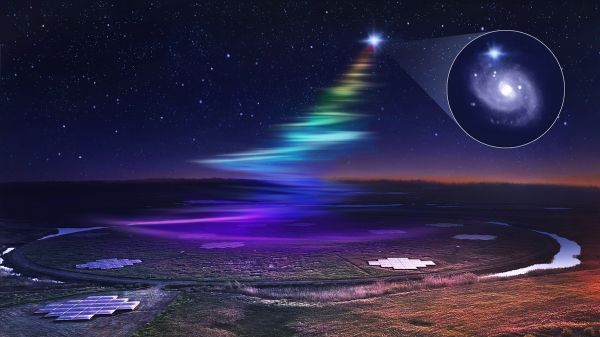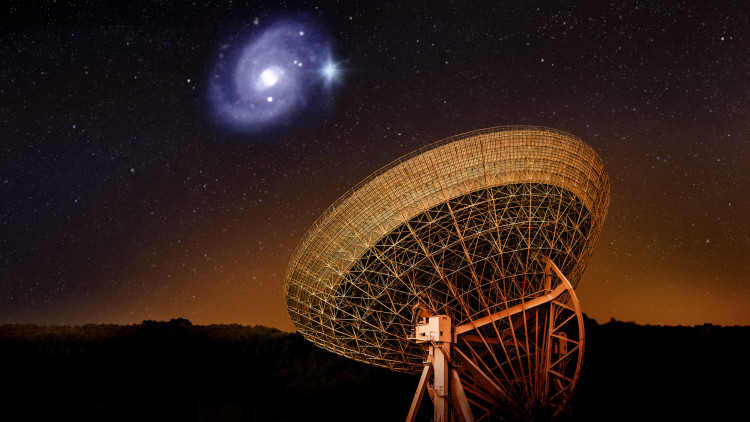Scientists paint best portrait yet of closest known fast radio burst
Two new studies paint a detailed portrait of the closest known FRB.

Scientists have uncovered more details about perhaps the most famous repeating fast radio burst, a mysterious phenomenon astronomers cannot yet explain.
Astronomers first spotted this fast radio burst, known as FRB20180916B, in 2018, just over a decade after FRBs were first discovered. Although some FRBs are individual flashes in the night, some cycle rhythmically over and over again; this particular FRB is of the latter category, bursting for four days and then remaining quiet for 12. It's also the closest FRB scientists have spotted thus far, at "only" 500 million light-years away.
The combination of frequent and close makes it a particularly appealing FRB to study, and two teams of researchers recently did just that.
Related: Top 10 strangest things in space
One team used dozens of detections made by the Low Frequency Array (LOFAR) in Europe and the Canadian Hydrogen Intensity Mapping Experiment (CHIME) to examine the wavelength range of radio waves produced by the FRB. The researchers were able to pick up emissions from FRB20180916B using LOFAR that were three times longer (with three times lower frequency) than previously observed emissions from the same FRB.
"This tells us that the region around the source of the bursts must be transparent to low-frequency emission, whereas some theories suggested that all low-frequency emission would be absorbed right away and could never be detected," Ziggy Pleunis, a physicist at McGill University in Canada and the lead author of one of the new studies, said in a statement.
In addition, these particularly long wavelengths of the FRB took longer to cross the vast distance from the FRB's source to Earth's detectors. For each rhythmic outburst, LOFAR detected longer radio waves about three days after CHIME detected shorter radio waves.
Sign up for the Live Science daily newsletter now
Get the world’s most fascinating discoveries delivered straight to your inbox.
"This systematic delay rules out explanations for the periodic activity that do not allow for the frequency dependence and thus brings us a few steps closer to understanding the origin of these mysterious bursts," Daniele Michilli, a co-author on the paper and another physicist at McGill, said in the same statement.

The second new paper about this FRB is based on observations gathered by the European Very-long-baseline Interferometery Network. The research uses a characteristic of light called polarization encoded within four of the FRB's outbursts to study how the light in each pulse changes over time.
Previous research had found FRB pulses varying at a scale of 30 microseconds, or millionths of a second. But the new research shows that at least for this particular FRB, some facets of the signal last just a few microseconds, even as other characteristics play out over longer time scales.
Scientists hope that all of these new observations could help narrow the range of theories behind what causes FRBs. In particular, the researchers on the first paper propose that their study points to a scenario in which a magnetic superdense stellar corpse called a magnetar is interacting with a large companion star with at least 10 times the mass of our sun. In that scenario, the FRB would be produced as the stream of charged particles flowing off the companion star "combs" through the magnetically governed area around the magnetar.
Whether that theory holds up will depend on future observations of FRB20180916B.
The research is described in papers published in the journals Nature Astronomy on March 22 and The Astrophysical Journal Letters on April 9.
Email Meghan Bartels at mbartels@space.com or follow her on Twitter @meghanbartels. Follow us on Twitter @Spacedotcom and on Facebook.
Meghan is a senior writer at Space.com and has more than five years' experience as a science journalist based in New York City. She joined Space.com in July 2018, with previous writing published in outlets including Newsweek and Audubon. Meghan earned an MA in science journalism from New York University and a BA in classics from Georgetown University, and in her free time she enjoys reading and visiting museums. Follow her on Twitter at @meghanbartels.










